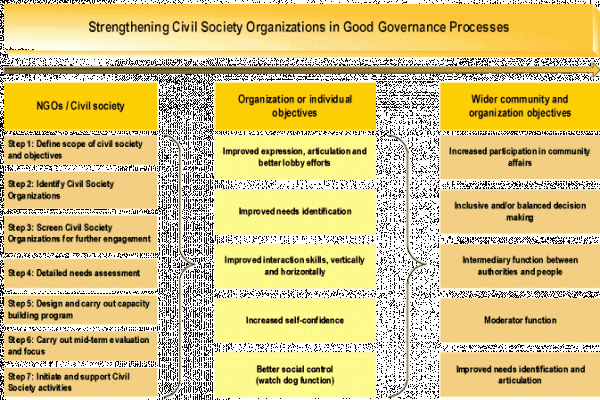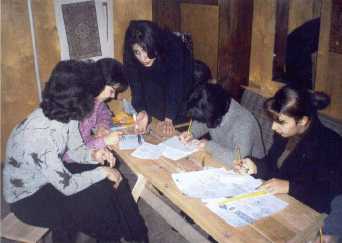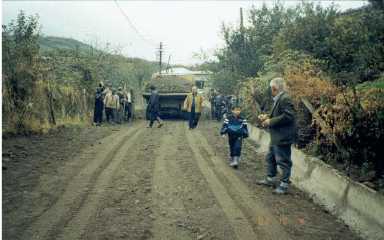|

|
Step 1: Define the scope of the term civil society and the objective of the intervention
The working definition should be broad enough to encompass a wide spectrum of entities while at the same clearly excluding those entities which do not fall within any plausible understanding of the term. A good example of a functional definition is “a group that is neither in the state nor private sector but is engaged in a public activity aiming to advance the interest of values of its members or society”.
CSOs can fulfil many different functions. At the beginning of the exercise it is important to define the exact objective of the activities. For example, “increase CSO involvement in local government affairs” or “strengthen the ability of CSO in articulation of needs” may be identified as the project objectives. Furthermore, CSOs are always part of a system and therefore play a certain role. It is important to understand the different roles CSOs play and how to support them in these roles.
Step 2: Identify CSO in target area
Once a common understanding of the term “Civil Society Organization” is agreed upon, a survey is carried out in the project area to identify existing civil society organizations (CSOs). In order to capture as accurate a picture as possible, the surveys are carried out by trained individuals with good knowledge of the area.
The surveys are conducted at the provincial, regional, and local level and should gather the following information:
- the name, address and date of foundation of organization;
- the number of members and the name of contact person;
- formal status;
- historical background;
- sphere of influence and activity;
- restrictions, achievements and successes;
- shortcomings;
- plans and ideas;
- comments of interviewers.
All organizations which meet the definition of civil society defined above should be included in the survey report, even those organizations which are not active at the time of the survey. The survey should not be limited to formally registered organizations. Rather, effort should be made to go to the communities and villages to reveal informal and nonregistered civil society groups. At this stage it is important to obtain as complete a list as possible of civil society groups in the target area.
Figure 1: Seven-step model for strengthening civil society organisations

|
|

|
Step 3: Screening of revealed CSO
Once the identification survey is complete, all CSOs must be screened to determine which entities will participate in a more detailed Needs Assessment. The scope and objective defined in the first steps is used to pre-select the CSO for further activities . This selection process is conducted by trained moderators.
When targeting groups to participate in the needs assessment consideration must, of course, be given to their demonstrated interest in receiving capacity building training. Clear selection criteria should be developed in advance of the targeting exercise and with a view to capturing those CSOs that would benefit the most from capacity training. Finally, the selection criteria should follow from the stated objectives of the training program. Criteria to consider in targeting groups for participation in the needs assessment will include:
- Is the group representative of a larger population and formed through elections held by that larger population (such as labour unions, parents committees, and teachers’ councils)? Selection of groups meeting this criterion will address the core objective of increasing participation on a community level.
- Does the group have multiple fields of activity and operate on a community level (such as civic action groups, village elders, and town elders)? Again, selection of groups meeting this criterion will address the core objective of increasing participation on a community level.
- Does the group act on the provincial level? Selection of groups meeting this criterion will address the core objective of increasing civil society representatives’ capacity to act as a moderator between elected and appointed authorities.
- Do the organizations represent the interest of a particular or discrete segment of society, particularly a segment which has traditionally been under-represented (such as women or youth groups)? Selection of groups meeting this criterion will address the core objective of enhancing inclusive and balanced decision making on different levels.
Step 4: Needs Assessment
Conduct a needs assessment of the targeted CSOs in order to determine their relative strengths and weaknesses. The needs assessment should be undertaken by trained moderators and use a predetermined, set methodology including focus-group discussions, questionnaires, and in-depth follow-up interviews that follow focus group discussions. The needs assessment should ascertain both material needs, such as office space and equipment, and deficits in skills. Clustering the identified CSOs according to the above-mentioned criteria can be very helpful at this step. |
 |
Step 5: Design and conduct capacity building training
A capacity building training programme is designed and implemented based upon the results of the Needs Assessment,
The following steps are required:
- Development of training modules and materials: Training materials must be developed reflecting the specific requirements revealed by the needs assessment. For example, modules and materials may be required on topics such as NGO organizational development, cooperation skills, and community involvement. The findings of the needs assessment will determine the content of the training module and it will thus reflect the specific needs and objectives of
- Depending on existing capacities, a Training of Trainers (ToT) workshop might be needed. A team of professional trainers has to be formed and trained in training methodologies. At the end of the ToT workshop, the team of trainers should have acquired the necessary training skills and methodologies, such as role playing, brainstorming, effective lecturing, and leading group discussions.
- Conduct the training of Civil Society Organizations over several days. Organizations participate in both group workshops addressing broad themes and common needs and more specific training workshops tailored to address particular weaknesses or needs revealed during the needs assessments.
Photo 2: Developing a strategy

Step 6: Mid-term evaluation
During the implementation of the training program, a mid-term evaluation is conducted.
The mid-term evaluation is designed to detect errors and omissions in both the content and delivery of the training programs and provide the opportunity to correct these problems.
The evaluation sought feedback on the number of topics covered in the training, the applicability of the topics, the accessibility of the training modules, the professionalism of the presentations, the supporting and visual aids, the training venue, the number of trainers and participants, and the trainer’s professionalism and skill. A sample evaluation sheet is provided in Figure 2.
Figure 2: Sample Mid-Term Evaluation Sheet

|
 |
Step 7: Select a sampling of CSO representatives to participate in activities
Based on the mid-term evaluations, a sample of CSO representatives, judged to be well trained and prepared to put their new skills into action, are selected to participate in follow-up activities involving community development and good governance.
Facilitated meetings are held between CSOs and local government and other organizations to ensure the continued participation of the newly trained CSOs in civic and governance matters.
One example of a follow-up activity in which the newly trained civil society representatives can be engaged includes the Peace and Conflict Impact Assessment (PCIA). By working together with local councils the civil society representative can help to identify local conflicts which must be taken into account by government and other actors in the design and implementation of community development project.
Photo 3: Community joining together to repair a road

|






